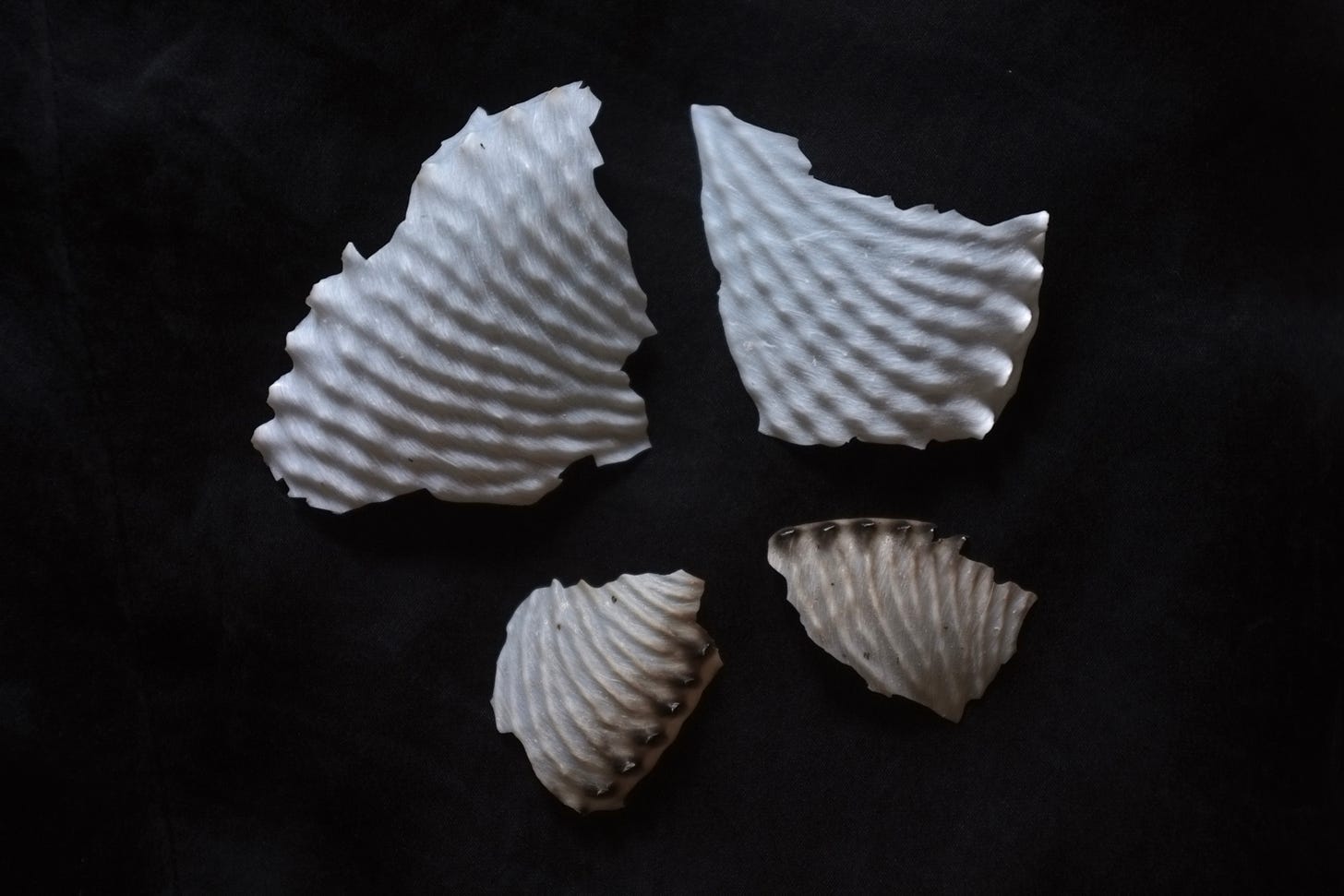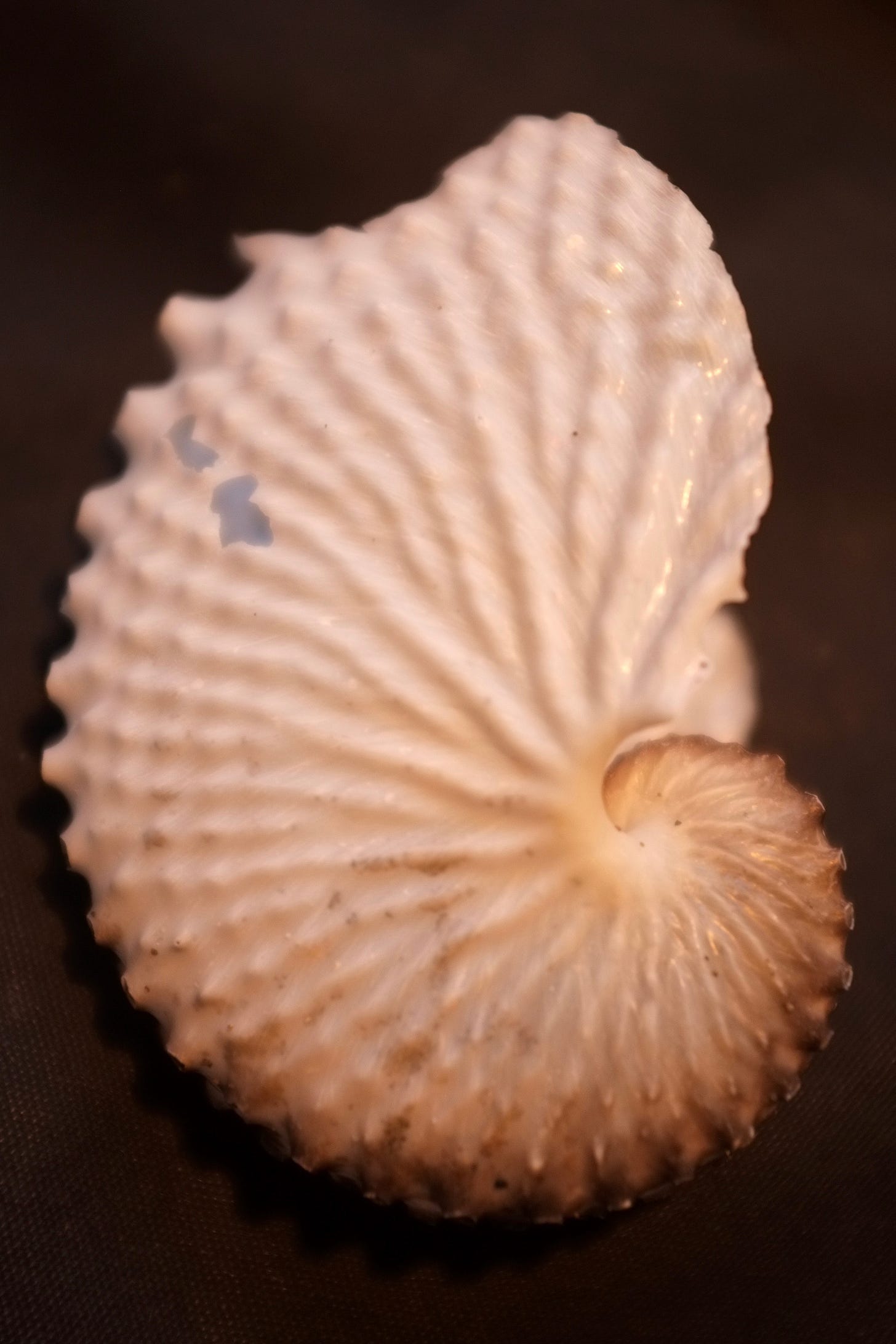The Pūpū Tarakihi / Paper Nautilus Method of Wizarding
On bespoke self-construction in the pelagic zone
Ursula K. Le Guin: ‘The exercise of imagination is dangerous to those who profit from the way things are because it has the power to show that the way things are is not permanent, not universal, not necessary... The storyteller is the truth-teller.’
Walt Whitman: ‘It is time to explain myself—let us stand up. / What is known I strip away, I launch all men and women forward with me into the Unknown.’
Consider the pūpū tarakihi / paper nautilus method of wizarding, of art: whilst making your home in the open ocean, excrete an elegant Fibonacci vessel from your own body, in which to incubate your tiny delicate mind-children. If the fragile ship of thought is damaged, repair the hole with calcite in an almost-invisible mend.
The names of the creature. Pūpū tarakihi: a mashup of the words for a sea-snail and a silvery fish.1 Paper nautilus: naming the beast by the byproduct, the empty shell that washes up on the shore once it's done with. Argonaut: Argonauta nodosa / nodosus, 'Sailor of the Argo', with bumps on— knobbled.2 (The Argo, 'swift', was the ship that Jason sailed in to seek the golden fleece.3) Argos literally means shining, bright, and comes from the same root word as argent, meaning silver. Nautilus means a sailor, too.
Nautical names. In the 4th century BC, Aristotle speculated that the argonaut used its pair of large webbed dorsal arms as sails to catch the wind, and its other six arms to row.4
Argonauts were long thought to borrow their shells from some other animal, rather than to make them.5 It was a French seamstress-embroiderer and amateur naturalist, Jeanne Villepreux-Power,6 living in Sicily in the 1830s, who solved the puzzle of the argonaut's shell. She made sea-cages and watched for hours, and finally observed both how baby argonauts begin to make a shell, and how live adult argonauts repair shell-damage, using calcium carbonate excreted from those same strange dorsal arms. That’s how they mend, and that’s how they make. (Is embroidery— as a craft— analogous to the patched shell-mend?) Creatrixes. The shells can be so idiosyncratic, so variable from individual to individual, that divergent forms were taken for different species.7
(More about Villepreux-Power and her experiments: The Marginalian: The Seamstress Who Solved the Ancient Mystery of the Argonaut)
Villepreux-Power was watching the females, who begin to build the shell shortly after hatching, and remain in it for life. The shell-less males, in a case of extreme sexual dimorphism, are tiny, about the size of your little fingernail. For most of history, the only evidence of the male was the still-living severed sex-tentacle (hectocotylus) stashed away in the female's mantle. (The male dies after donating his sperm-arm, but the zombie tentacle lives on, ready to fertilise, who knows for how long?8) Nobody put two and two together— recognising the little and the large as the male and female of the same species— until a century ago.
Soft-bodied, like all mollusc-kind. A snail that learnt how to think, by way of studying for millennia. Argonauts can give a venomous bite with their beak, and like all cephalopods, can change colour and make ink. Camouflage and smokescreen. Eater and eaten.9
Calcite / calcium carbonate, the material the pūpū tarakihi shell is made of, is also what eggshells, snail shells, limestone, and pearls are made of. It's hard to describe the particular texture of the shell. My mind slips around on the surface of it, trying to find what it's like. Hard, shining, like tooth enamel. Fragile, translucent to the light, breakable as a bird's egg. Rippled in cross-currents like those on the water's surface, smooth-grooved, nacreous, like the inside of a pāua.
I think a lot about the surface of the sea as a site, a boundary, a skin. From underneath, it is as silvery and reflective as it is from above; a magic mirror. Sea-mammals are tethered to it by their breath-holding length. They show themselves to us dry-landers when they breathe, when they dip into the world of air. That ever-shifting meniscus is where our two worlds meet and kiss. The argonaut takes an air bubble from the surface and traps it in her shell, to regulate buoyancy in the water column. (The small dot of Yang inside the Yin, a piece of the opposing element at the heart of things, necessary for functioning.)
Why is this animal like art-magic? The rarity, the weirdness, the solitude, the self-made cradle.10 She is good to think about. Captivity will kill her.11 All sea creatures are inhabitants of an alien realm. Living afloat in the water column is like drifting in space. We, the wild makers and thinkers, are not rockpool-bound hermit crabs, putting our tail into someone else's cast-off shell, making it fit. Neither are we coral-reef denizens, like those who do their making-work within collective structures such as Universities. We are the creators of our own patterned vessels, patiently layering labour upon labour, doing it on the wing, in midwater. There is no safe space other than what we make from our own bodies.
World-making work; making space. Creating cosmologies requires the fortitude to discard or ignore cultural biases that are harmful or irrelevant. The purpose— the function— of the beautiful shell is as a ship to carry the unknowable shining living being, to cradle her hundred thousand ideas from conception to hatching. Beauty is incidental. (Baby seed-ideas scatter to the currents, begin to make their own shells.) I love an animal that no one understands. The sea is full of them, infinitely various and mysterious. I’m not quite trying to make a manifesto, I’m trying to net a metaphor for how things already feel. (Is that or isn’t it the same thing?)

A New Zealand Geographic story with beautiful photos: The Legend of the Argonaut
The word tarakihi also means a cicada, another creature that makes a crunchy shell— an exuvia— in the course of its metamorphosis from nymph to adult.
Maggie Nelson, from her amazing memoir The Argonauts: “A day or two after my love pronouncement, now feral with vulnerability, I sent you the passage from Roland Barthes by Roland Barthes in which Barthes describes how the subject who utters the phrase “I love you” is like “the Argonaut renewing his ship during its voyage without changing its name.” Just as the Argo’s parts may be replaced over time but the boat is still called the Argo, whenever the lover utters the phrase “I love you,” its meaning must be renewed by each use, as “the very task of love and of language is to give to one and the same phrase inflections which will be forever new.’”
She also says: “Empirically speaking, we are made of star stuff. Why aren't we talking more about that? Materials never leave this world. They just keep recycling, recombining. That's what you kept telling me when we first met—that in a real, material sense, what is made from where. I didn't have a clue what you were talking about, but I could see you burned for it. I wanted to be near that burning.”
Argo is also the name given to a huge constellation, seen as a ship by the Egyptians, the Sumerians (maybe), and the Greeks. (Vedic-period Indian astrologers also saw this star-cluster as a boat.) Considered too large, it was broken down in the nineteenth century into multiple smaller constellations: Carina (the keel), Puppis (the poop deck) and Vela (the sails). To find it, take Crux— the Southern Cross— as a marker. Swivel your orientation until the cross is upright: Argo lies rightward of its right hand arm. More about Argo here: https://www.nzgeo.com/stories/the-good-ship-argo/
Technically, arms are cephalopod limbs with suckers all along them. Tentacles are the club-like appendages squids have two of.
Upstart crow…
Married to an Irishman, hence ‘Power’. Leaving Sicily in the 1840s, the ship carrying her possessions to London & Paris was wrecked, and most of her scientific drawings and records were lost. There is a crater on Venus named after her.
The chart that records people’s speculative attempts at argonaut taxonomy is full of boxes saying undetermined, unresolved, not designated, uncertain.
Not even Steve O’Shea knows.
Preys upon: crustaceans, molluscs, jellyfish, salps. Preyed upon by: tuna, billfish, dolphins.
I note that she is solitary, vulnerable, and female. This is not to infer that I am alone and unsupported— like most makers, I work in a web of connections and cross-inspirations— but rather that certain work is by its very nature personal, idiosyncratic, and partially arcane.
George Orwell: “At present we know only that the imagination, like certain wild animals, will not breed in captivity.”





How wonderful. How full of wonder! Glad to see you set off in your Argo. Et in Arcadia Argo? One day, maybe....